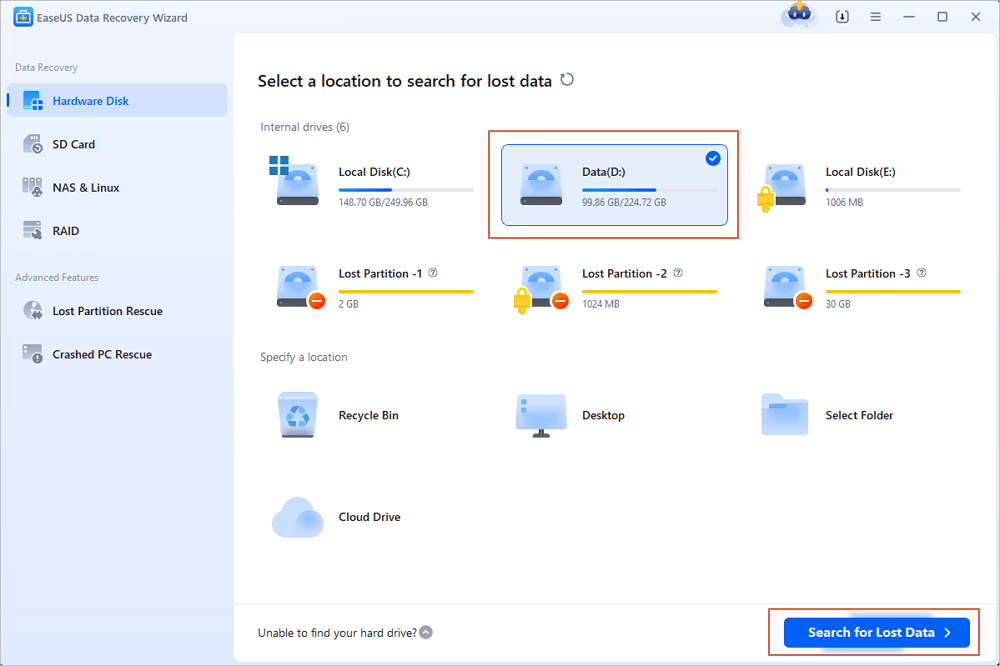2024 Tutorial: Recover RAID Data with RAID Recovery Software
Daisy updated on Jan 09, 2024 to Data Recovery Resource | How-to Articles
With the professional and reliable RAID recovery software - EaseUS Data Recovery Wizard, you can easily recover data from any RAID hard drive that can be recognized by your computer system, whether it is RAID 0, RAID 1, RAID 5, RAID 10 or other hardware RAIDs.
The reason why users need a RAID recovery is the same as that of the normal hard disk data recovery. A broken or corrupted RAID can result from human errors, hardware or software failure, malware infection, mechanical errors, power outage, bad sectors, or abrupt system shutdown, etc. But there's something different when you want to recover a broken RAID.
When the RAID is damaged, the RAID volume becomes inaccessible, and the data is lost. But you are unable to access or recover data from RAID hard drives directly. You need to reconstruct or rebuild the RAID configuration to get back lost data, which users find the most difficult. Luckily, there are lots of third-party data recovery software that can help you simplify this process. Keep reading and check more details.
To recover data from RAID drives, choosing a professional RAID recovery software is greatly helpful! EaseUS Data Recovery Wizard provides you with the complete RAID data recovery solutions under Windows. Be it RAID 0, RAID 1, RAID 5, or RAID 10, EaseUS RAID recovery software will help you recover data from any RAID hard drive, as long as your computer system can recognize it.
Don't hesitate to equip your computer with such a powerful tool. With this software, you can get files back from RAID hard drive with the 3-step process:
Scan disks > Preview and select wanted files > Recover data.
Now follow the steps below to recover RAID data with the help of EaseUS Data Recovery Wizard:
Step 1. Scan the RAID drive
Choose the RAID drive from which you wish to recover data, and then click "Scan". Wait for the scanning process to finish, the deleted files will show up one by one.

Step 2. Find and preview lost RAID files
You can use "Filter" as quick navigation to find deleted or lost files. Besides, you can also use Search to find your lost RAID drive files via its file name or file extension.
Step 3. Restore lost RAID drive files
Select the wanted files and click "Recover". Browse to save these files to another secure location.
Also, watch this video tutorial to learn how to recover RAID data with EaseUS Data Recovery Wizard.
Other than RAID data recovery, EaseUS data recovery software also allows you to:
Consult with EaseUS data recovery experts for one-on-one manual recovery service. We could offer the following services after FREE diagnosis. Our decades-experienced engineers are knowledgeable and can repair the damaged RAID structure and restore data from all RAID levels.
Before introducing the professional RAID data recovery software, let's learn some basic knowledge about RAID.
RAID, Redundant Array of Inexpensive Disks or Redundant Array of Independent Disks, is a data storage virtualization technology that provides a way of storing the same data in different places on multiple physical hard disks for the purpose of increasing your system performance or providing fault tolerance.
Data is allocated on RAID hard drives in different ways, referred to as RAID levels, including RAID 0, 1, 2, 3, 4, 5, 6, and 10. The explanations of commonest RAID levels:
| Level | Definition |
|---|---|
| RAID 0 | (Striped Disk Array without Fault Tolerance) RAID 0 provides data striping (spreading out blocks of each file across multiple disk drives) but no redundancy. This improves performance but does not deliver fault tolerance. If one drive fails then all data in the array is lost. |
| RAID 1 | (Mirroring Volume) RAID 1 provides disk mirroring. Level 1 provides twice the read transaction rate of single disks and the same write transaction rate as single disks. |
| RAID 5 | (Block Interleaved Distributed Parity) RAID 5 provides data striping at the byte level and also stripe error correction information. This results in excellent performance and good fault tolerance. Level 5 is one of the most popular implementations of the RAID. Give its popularity, it's necessary to know how to back up RAID drives to avoid complete data loss. |
| RAID 6 | (Independent data disks with double parity) RAID 6 requires a minimum of four disks. It uses two parity stripes on each disk and allows for two disk failures within the RAID set. The double parity makes it provide high fault tolerance and more expensive since the two extra disks required for parity. |
| RAID 10 | (A Mirror of Stripes) RAID 10, also called RAID 1+0, is not one of the original RAID levels, two RAID 0 stripes are created, and a RAID 1 mirror is created over them. Used for both replicating and sharing data among disks. |
Generally, RAID uses multiple disks working together to increase overall system performance for computer users, especially server users. Besides, it also has the following benefits:
However, although RAID provides higher data security, data loss on RAID hard drives happens. You may suffer data loss on RAID disks or drives due to system crash, virus attack, power failure/surge, or other unexpected errors. You may think that RAID data recovery is complicated. As long as you get the right RAID recovery software, you can recover data from your RAID hard drives safely and effectively with ease.
Related Articles
Free Download Easy Recovery Software to Restore Lost Data in 2024
How to Recover Deleted Files by Date/Time
How to Recover Deleted Call Recordings on Android [2024 Guide]
How to Restart File Explorer in Windows 10/11 | NEW